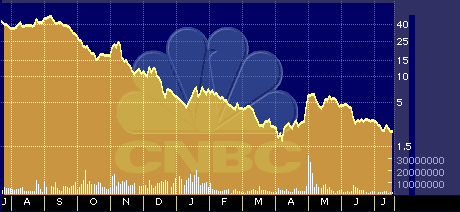
AltaVista IPO Seen Big, Despite Losses
AltaVista IPO Seen Big, Despite Losses
by Hal Plotkin
Silicon Valley Correspondent
Analysts say AltaVista Co.’s pending initial public offering is likely to be a big success, despite the firm’s sizable financial losses.
“I suspect the reaction to the IPO will be fairly spectacular, primarily because of the company’s relationship with CMGI,” says David Simons, managing director of Digital Video Investments, a New York-based institutional research firm.
Palo Alto, Calif.-based AltaVista started out as a search engine and has since become a hybrid search, portal and free Internet service provider. The company is being spun off from Andover, Mass.-based CMGI Inc. {CMGI}, a major Internet firm incubator and holding company. CMGI acquired AltaVista from Compaq Computer Corp. {CPQ} in August for about $2.3 billion in a deal that sent heads spinning.
Analysts say the acquisition by CMGI boosted AltaVista’s value.
“They are no longer the Internet arm of a hardware company,” says Cameron Meierhoefer, Internet analyst at PC Data Online, based in Reston, Va. “They are now the Internet aggregator of a major Internet holding company.”

CMGI 52-week stock performance
“I expect the IPO will do quite well,” adds Phil Daniels, another PC Data Online analyst. “They have a widely recognized brand and are reaching over 10 million users a month. That’s nothing to sneeze at.”
Daniels, like several other analysts, says he doesn’t think Wall Street will be troubled by the huge losses reported in AltaVista’s S-1, the firm’s official pre-IPO filing with the Securities and Exchange Commission.
Including stock-based compensation and amortization of intangibles, AltaVista’s loss totaled $267.7 million for the seven months ended Oct. 31, as compared with a loss, also including stock-based compensation and amortization of intangibles, of $939.1 million for the year ended Dec. 31, 1998. In total, as of Oct. 31, AltaVista reported a staggering accumulated deficit of $492.9 million.
Most of those losses can be attributed to AltaVista’s aggressive acquisition strategy, as well as CMGI charging off the cost of AltaVista’s purchase against AltaVista’s balance sheet on a multi-year basis. Looked at in terms of AltaVista’s actual operations, losses are much smaller, though still substantial: $46.3 million lost for the seven months ended Oct. 31, compared with $56.9 million in red ink over the prior year.
“It’s really not that different from a lot of Internet companies that have a huge market capitalization but haven’t made any money,” says Kathey Hale, principal analyst at Dataquest, based in San Jose, Calif. “A lot of companies going public have had massive infusions of capital. In this case, Compaq was able to get a lot of the value out, in terms of the sale price, pre-IPO.”
Hale says she doesn’t think investors will balk at the IPO, despite the firm’s losses which, she notes, are largely tied to it’s own acquisition costs. “But there is a question mark here,” she says. “And that’s the psychological shock of reading the S-1. It’s hard to say how investors will react to that. I don’t think it’s going to be a flop. But I don’t think it’s going to be one of those [stocks that jumps dramatically] either.”
“It looks like what CMGI is doing is selling the debt back to the public,” Meierhoefer says. “That’s pretty curious. When it comes to debt, though, Amazon.com {AMZN} is the king and it hasn’t seemed to hurt them any.”
One of the reasons for analyst optimism about AltaVista stems from the company’s position as a key CMGI holding. CMGI is one of the best-known Internet incubators and holding companies. CMGI’s strategy, which has thus far met with considerable investor enthusiasm, involves combining a number of complementary Internet companies in an informal consortium that drives business to and between each of the businesses.
CMGI’s holdings include Web-hosting services company NaviSite Inc. {NAVI}, which went public in October at $14 a share, and Engage Technologies Inc. {ENGA}, an online advertising and customer profiling firm that went public in July at $15 a share.

NaviSite post-IPO stock performance

Engage post-IPO stock performance
CMGI also has majority ownership interests in more than a dozen other Internet firms, including 1ClickCharge, Activerse, Adsmart, iCast, Magnitude Network, MyWay.com (formerly Planet Direct), Nascent Technologies, NaviNet, ZineZone, and Zip2, among others.
The consortium of CMGI companies is sometimes referred to as an Internet keretsu, a Japanese word that refers to interlocking partnerships between major firms that operate under a single umbrella.
“In a traditional financial market, the keretsu that CMGI has set up would probably be doomed,” says Joel Yaffe, an analyst at Giga Information Group, based in Boston. That would normally be the case, he says, because of the heavy losses being posted by many CMGI firms.
“But the current market changes the dynamics,” Yaffe says. “Investors find the CMGI keretsu very attractive.”
AltaVista, for example, is benefiting from strong and growing business ties to other CMGI firms. “For most start-ups, it’s catch as catch can. AltaVista doesn’t have that problem. They are in a much stronger position than an independent competitor would be.”
David Simons, of Digital Video Investments, agrees. He says CMGI has done a very good job of bringing its Internet holdings public at just the right time.
“Unlike some other incubators, they haven’t tended to rush companies to an IPO until they have some confidence they’re ready to stand alone as viable businesses,” Simons says. Simons recently wrote an article on CMGI’s business strategy for the trade journal The Industry Standard.
Read David Simons’ article from The Industry Standard
AltaVista is, however, facing lots of competitors, most notably America Online Inc. {AOL} and Yahoo! Inc. {YHOO} but also Excite@Home {ATHM}, LookSmart Ltd. {LOOK}, Lycos Inc. {LCOS}, Microsoft Corp.’s {MSFT} MSN, Snap!, and a relative newcomer, Google, among others. Yahoo! and AOL appear to have a lock, at least at present, on the No. 1 and No. 2 online portal positions.
AltaVista, in contrast, consistently ranks in or very near the top 10 of online sites in terms of the total number of visitors. AltaVista users also tend to be more loyal than users of many other portal sites, according to a recent study by PC Data Online.
“That’s very good for them,” Daniels says. “It means they’ve been doing a good job, that customers are satisfied with them. That gives them a lot of opportunities moving forward.”
AltaVista is doing as much as it can to capitalize on those opportunities. In recent months, for example, the company acquired Shopping.com, an online price-comparison service, and announced the acquisition of Raging Bull, an investment-oriented message-board service, both of which now have links on the AltaVista homepage.
“They’ve still got a lot of catching up to do compared with AOL, Microsoft, and Yahoo!,” says Paul Hagen, senior analyst at Forrester Research, based in Cambridge, Mass. “Our sense is that there will only be three or four major portals in the future. AltaVista is not No. 1 or No. 2, so they are on the edge of that. But if there is a Cinderella in the rest of that group, they’d be it.”
So what’s Hagen’s take on the pending IPO? “I think it will probably do very well,” he says. “They are creating more functionality on the site and they’ve done a great job with the brand.”
AltaVista’s IPO is expected to be scheduled shortly after the beginning of next year.


